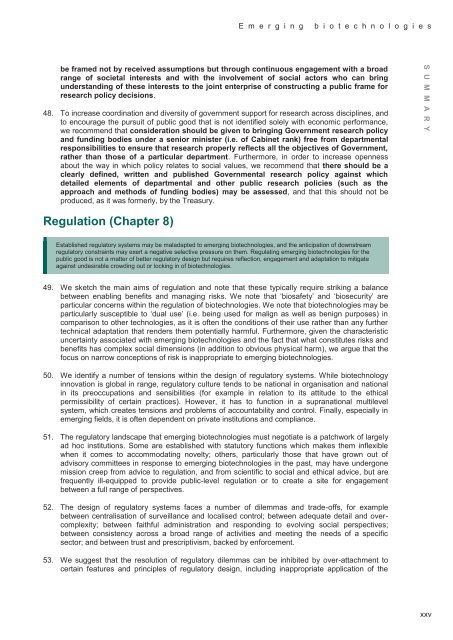Emerging biotechnologies: full report - Nuffield Council on Bioethics
Emerging biotechnologies: full report - Nuffield Council on Bioethics
Emerging biotechnologies: full report - Nuffield Council on Bioethics
Create successful ePaper yourself
Turn your PDF publications into a flip-book with our unique Google optimized e-Paper software.
E m e r g i n g b i o t e c h n o l o g i e s<br />
be framed not by received assumpti<strong>on</strong>s but through c<strong>on</strong>tinuous engagement with a broad<br />
range of societal interests and with the involvement of social actors who can bring<br />
understanding of these interests to the joint enterprise of c<strong>on</strong>structing a public frame for<br />
research policy decisi<strong>on</strong>s.<br />
48. To increase coordinati<strong>on</strong> and diversity of government support for research across disciplines, and<br />
to encourage the pursuit of public good that is not identified solely with ec<strong>on</strong>omic performance,<br />
we recommend that c<strong>on</strong>siderati<strong>on</strong> should be given to bringing Government research policy<br />
and funding bodies under a senior minister (i.e. of Cabinet rank) free from departmental<br />
resp<strong>on</strong>sibilities to ensure that research properly reflects all the objectives of Government,<br />
rather than those of a particular department. Furthermore, in order to increase openness<br />
about the way in which policy relates to social values, we recommend that there should be a<br />
clearly defined, written and published Governmental research policy against which<br />
detailed elements of departmental and other public research policies (such as the<br />
approach and methods of funding bodies) may be assessed, and that this should not be<br />
produced, as it was formerly, by the Treasury.<br />
S U M M A R Y<br />
Regulati<strong>on</strong> (Chapter 8)<br />
Established regulatory systems may be maladapted to emerging <str<strong>on</strong>g>biotechnologies</str<strong>on</strong>g>, and the anticipati<strong>on</strong> of downstream<br />
regulatory c<strong>on</strong>straints may exert a negative selective pressure <strong>on</strong> them. Regulating emerging <str<strong>on</strong>g>biotechnologies</str<strong>on</strong>g> for the<br />
public good is not a matter of better regulatory design but requires reflecti<strong>on</strong>, engagement and adaptati<strong>on</strong> to mitigate<br />
against undesirable crowding out or locking in of <str<strong>on</strong>g>biotechnologies</str<strong>on</strong>g>.<br />
49. We sketch the main aims of regulati<strong>on</strong> and note that these typically require striking a balance<br />
between enabling benefits and managing risks. We note that ‘biosafety’ and ‘biosecurity’ are<br />
particular c<strong>on</strong>cerns within the regulati<strong>on</strong> of <str<strong>on</strong>g>biotechnologies</str<strong>on</strong>g>. We note that <str<strong>on</strong>g>biotechnologies</str<strong>on</strong>g> may be<br />
particularly susceptible to ‘dual use’ (i.e. being used for malign as well as benign purposes) in<br />
comparis<strong>on</strong> to other technologies, as it is often the c<strong>on</strong>diti<strong>on</strong>s of their use rather than any further<br />
technical adaptati<strong>on</strong> that renders them potentially harmful. Furthermore, given the characteristic<br />
uncertainty associated with emerging <str<strong>on</strong>g>biotechnologies</str<strong>on</strong>g> and the fact that what c<strong>on</strong>stitutes risks and<br />
benefits has complex social dimensi<strong>on</strong>s (in additi<strong>on</strong> to obvious physical harm), we argue that the<br />
focus <strong>on</strong> narrow c<strong>on</strong>cepti<strong>on</strong>s of risk is inappropriate to emerging <str<strong>on</strong>g>biotechnologies</str<strong>on</strong>g>.<br />
50. We identify a number of tensi<strong>on</strong>s within the design of regulatory systems. While biotechnology<br />
innovati<strong>on</strong> is global in range, regulatory culture tends to be nati<strong>on</strong>al in organisati<strong>on</strong> and nati<strong>on</strong>al<br />
in its preoccupati<strong>on</strong>s and sensibilities (for example in relati<strong>on</strong> to its attitude to the ethical<br />
permissibility of certain practices). However, it has to functi<strong>on</strong> in a supranati<strong>on</strong>al multilevel<br />
system, which creates tensi<strong>on</strong>s and problems of accountability and c<strong>on</strong>trol. Finally, especially in<br />
emerging fields, it is often dependent <strong>on</strong> private instituti<strong>on</strong>s and compliance.<br />
51. The regulatory landscape that emerging <str<strong>on</strong>g>biotechnologies</str<strong>on</strong>g> must negotiate is a patchwork of largely<br />
ad hoc instituti<strong>on</strong>s. Some are established with statutory functi<strong>on</strong>s which makes them inflexible<br />
when it comes to accommodating novelty; others, particularly those that have grown out of<br />
advisory committees in resp<strong>on</strong>se to emerging <str<strong>on</strong>g>biotechnologies</str<strong>on</strong>g> in the past, may have underg<strong>on</strong>e<br />
missi<strong>on</strong> creep from advice to regulati<strong>on</strong>, and from scientific to social and ethical advice, but are<br />
frequently ill-equipped to provide public-level regulati<strong>on</strong> or to create a site for engagement<br />
between a <str<strong>on</strong>g>full</str<strong>on</strong>g> range of perspectives.<br />
52. The design of regulatory systems faces a number of dilemmas and trade-offs, for example<br />
between centralisati<strong>on</strong> of surveillance and localised c<strong>on</strong>trol; between adequate detail and overcomplexity;<br />
between faithful administrati<strong>on</strong> and resp<strong>on</strong>ding to evolving social perspectives;<br />
between c<strong>on</strong>sistency across a broad range of activities and meeting the needs of a specific<br />
sector; and between trust and prescriptivism, backed by enforcement.<br />
53. We suggest that the resoluti<strong>on</strong> of regulatory dilemmas can be inhibited by over-attachment to<br />
certain features and principles of regulatory design, including inappropriate applicati<strong>on</strong> of the<br />
xxv
















